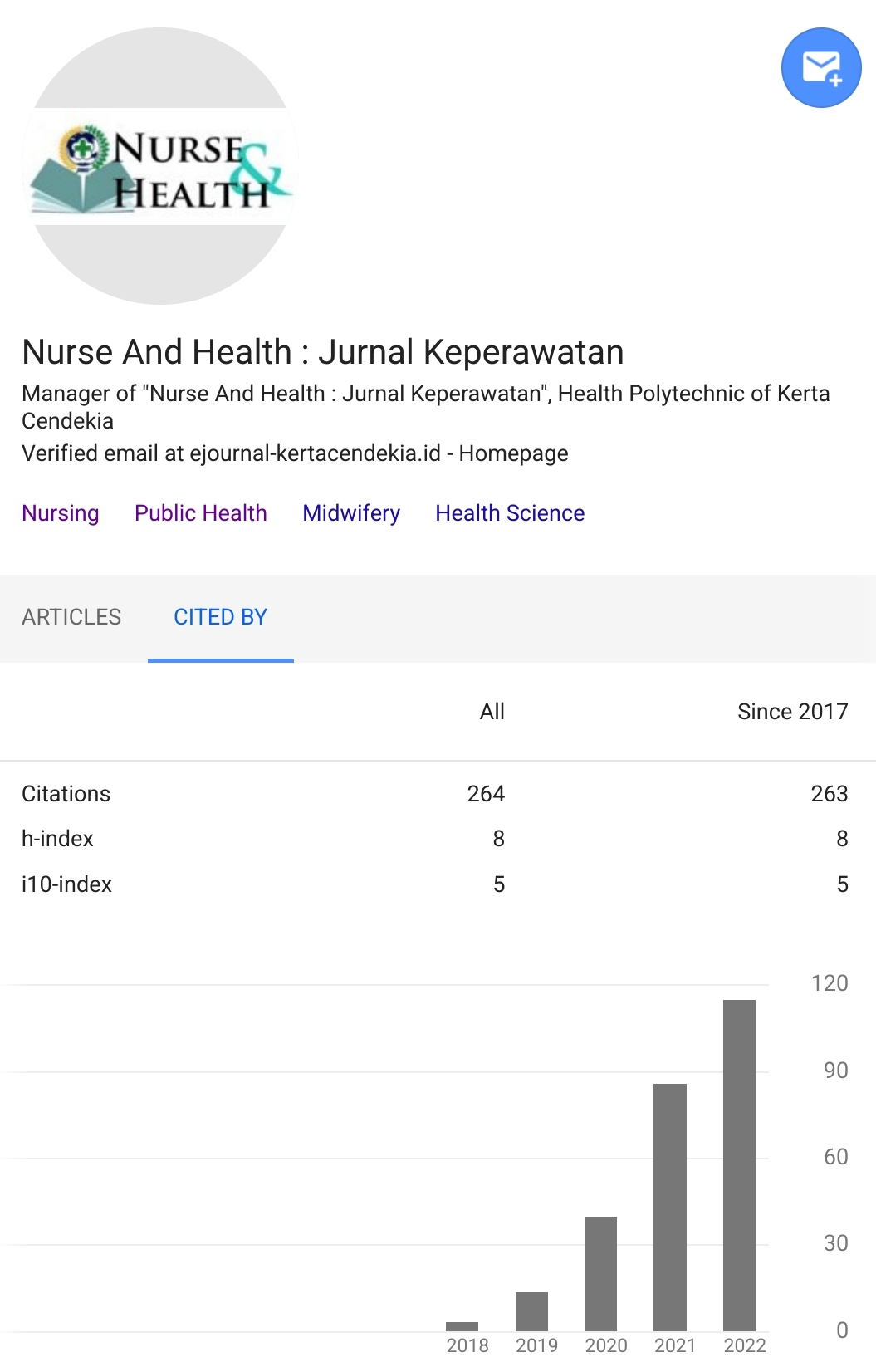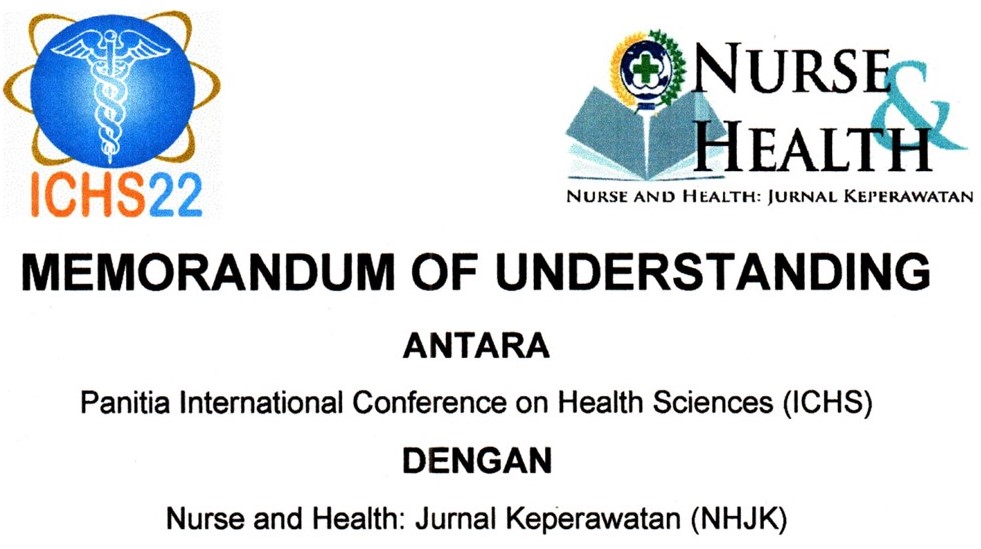ANALYSIS OF THE ROLE OF MIDWIVES ON THE SELECTION OF IMPLANTED CONTRACEPTIVE USE BY ACCEPTORS: A LITERATURE REVIEW
Abstract
Background: Indonesian family profiles reported the percentage of active acceptors in couples of childbearing ages in 2017 was 63.22%, and the number who never used contraceptives was 18.63%. The highest contraceptive use in Bengkulu province was 71.98%, and the lowest in Papua was 25.73%. The population of Papua Province in 2020 amounted to 4.3 million people or an increase of 1.47 million. Objectives: This study aims to find the role of midwives against the selection of the use of implanted contraceptives by acceptors. Design: This research design is a systematic review to find and review articles from databases and theories that are descriptive. Data Sources: Search articles using databased ScienceDirect and Google Scholar including the keyword "contraceptive implants" with a period of 2018 to 2021; 15 articles are available based on inclusion criteria article discussing implant contraceptives, Year of publication 2018-2021, International and National Publications, the National Journal has ISSN, articles using Indonesian and English Review Methods: Systematic review methods based on established criteria, then collected and made journal summaries include the name of the researcher, the year of publication of the journal, the title of the study, the method, and a summary of the results or findings. by identifying, evaluating and synthesizing the summary of research journals entered into the table according to the format. Results: From the journal filtering, 15 articles were eligible based on the inclusion criteria, it was found that: The role of health workers/midwives is the most important factor in the use of implants contraception by acceptors so that it is hoped that education regarding the benefits of implants can be increased. Conclusion: Interpersonal communication or counseling needs to be improved. Counseling is communication between clients and health workers to facilitate and advocate on any issues related to comprehensive reproductive health. It is expected that with counseling provided by birth control, acceptors can make their own decisions in accordance with the desired method.Downloads
References
. K., Dewi Harahap, F. S., & Saragih, R. (2020). Perspektif Agama Islam Dan Kesehatan Tentang Penggunaan Alat Kontrasepsi (Akjp) Implant Di BPM Keluarga Sehat Kecamatan Darul Hasanah Kabupaten Aceh Tenggara Provinsi Aceh Tahun 2019. JOURNAL OF HEALTHCARE TECHNOLOGY AND MEDICINE. https://doi.org/10.33143/jhtm.v6i2.1086 DOI: https://doi.org/10.33143/jhtm.v6i2.1086
Affandi, B. (2013). Buku Panduan Praktis Pelayanan Kontrasepsi. In PT Bina Pustaka Sarwono Prawirohardjo.
Aisien, A. O., & Enosolease, M. E. (2010). Safety, efficacy and acceptability of Implanon a single rod implantable contraceptive (etonogestrel) in University of Benin Teaching Hospital. Nigerian Journal of Clinical Practice.
Balogun, O., Olaomo, N., Adeniran, A., & Fawole, A. (2014). Implanon sub-dermal implant: an emerging method of contraception in Ilorin, Nigeria. Journal of Medical and Biomedical Sciences. https://doi.org/10.4314/jmbs.v3i1.1 DOI: https://doi.org/10.4314/jmbs.v3i1.1
Botfield, J. R., Wright, S. M., Fenwick, S. E., & Cheng, Y. (2021). Training nurses in contraceptive implant procedures: implications for practice in Australia. Collegian. https://doi.org/10.1016/j.colegn.2020.04.005 DOI: https://doi.org/10.1016/j.colegn.2020.04.005
Bria, E. I. (2018). Hubungan Peran Tenaga Kesehatan dalam Memberikan Konseling KB dengan Penggunaan Alat Kontrasepsi pada Wanita Pasangan Usia Subur di Puskesmas Rafae Kabupaten Belu Nusa Tenggara Timur. Journal Universitas Airlangga.
Erlyna Evasari, & Sahara, F. A. (2018). Hubungan pengetahuan, pendidikan, dan dukungan keluarga dengan penggunaan alat kontasepsi implant. Jurnal Obstretika Scientia, 2(2), 108–127. https://ejurnal.latansamashiro.ac.id/index.php/OBS/article/view/171/170
Farlikhatun, L. (2019). Kontribusi Pengetahuan Ibu Terhadap Minat Penggunaan Kontrasepsi KB Implan. 2(2), 89–95.
Filmira, R. L., & Fatah, M. Z. (2020). Determinan keinginan penerapan program KB (Keluarga Berencana) pada remaja Pria Indonesia di Masa Mendatang. Journal of Health Science and Prevention.
Gustikawati, N., Wulandari, L. P. L., & Duarsa, D. P. (2014). Faktor Penghambat dan Pendukung Penggunaan Alat Kontrasepsi Implant di Wilayah Puskesmas I Denpasar Utara. Public Health and Preventive Medicine Archive. https://doi.org/10.15562/phpma.v2i2.141 DOI: https://doi.org/10.15562/phpma.v2i2.141
Hesti Cahya Ningrum, N. A. T. (2020). Peran Petugas Kesehatan Terhadap Pemakaian Kontrasepsi Pada Pekerja Tempat Hiburan Malam ( THM ) Di Wilayah Kerja Puskesmas Harapan Baru Samarinda. Borneo Student Research, 1(2), 914–919.
Hohmann, H. (2009). Examining the efficacy, safety, and patient acceptability of the etonogestrel implantable contraceptive. In Patient Preference and Adherence. https://doi.org/10.2147/PPA.S4299 DOI: https://doi.org/10.2147/PPA.S4299
Kemenkes RI. (2018). Profil Kesehatan Indonesia.
Kumaladewi, F., & Pelupessy, R. A. (2018). Determinan Pengambilan Keputusan Menjadi Akseptor Kontrasepsi Implan. Jurnal Ilmiah Kebidanan Indonesia. https://doi.org/10.33221/jiki.v8i04.178 DOI: https://doi.org/10.33221/jiki.v8i04.178
Laput, D. O., Manongga, S. P., & Prinata, E. (2021). Factors predicting of the Implant Contraceptive Used as Family Planning Method among Mothers in Wae Mbeleng Public Health Center , Ruteng Sub District. International Journal of Nursing and Health Services(IJNHS), 4(1), 97–111.
Mario, E., & Irma, A. (2020). Quality of Care in Modern Contraceptive Service Delivery in the Public and Private Sector: A Cross Sectional Study in Indonesia. Global Journal of Health Science. https://doi.org/10.5539/gjhs.v12n7p102 DOI: https://doi.org/10.5539/gjhs.v12n7p102
Masita, S., Baso, Y. S., Ramadany, S., Sharif, S., Hadju, V., & Nilawati Usman, A. (2021). Effect of application of counseling in fertile age couple on the improvement of knowledge contarception implants. Annals of the Romanian Society for Cell Biology.
Murtiawani, I. (2020). Analysis of Factors Affecting the Interest of Acceptors in Selecting Implant in Woman of Childbearing Age in the Working Area of Wonosari Public Health Centre. The 2nd Strada International Conference on Health, 2015, 264–275. https://doi.org/10.30994/sich2.v2i1.40
Nur, R., Bonda, R., & Rahman, A. (2019). Determinant Use of Long-Term Contraceptive Methods in Sangurara Community Health Center Area Palu City. Journal of Current Medical Research and Opinion. https://doi.org/10.15520/jcmro.v2i06.166 DOI: https://doi.org/10.15520/jcmro.v2i06.166
POPULATION REFERENCE BUREAU. (2019). 2019 World Population Data Sheet. 2019 World Population Data Sheet.
Pratiwi, I. G., & Restanty, D. A. (2018). Penerapan Aplikasi Berbasis Android “Status Gizi Balita Terhadap Pengetahuan Ibu Dalam Pemantauan Status Gizi Anak Usia 12-24 Bulan.” JKAKJ.
Purba, R., & Ibrahim. (2020). FAKTOR-FAKTOR YANG MEMPENGARUHI PASANGAN USIA SUBUR ( PUS ) DALAM MEMILIH KONTRASEPSI IMPLANT DI PUSKESMAS SEI LANGKAI. ZONA KEBIDANAN, 10(2), 109–120.
Sugiana, E., Hamid, S. A., & Sari, E. P. (2021). Faktor-Faktor yang Mempengaruhi Penggunaan Kontrasepsi Implant. Jurnal Ilmiah Universitas Batanghari Jambi. https://doi.org/10.33087/jiubj.v21i1.1142 DOI: https://doi.org/10.33087/jiubj.v21i1.1142
Tampubolon, I. L., & Tarigan, J. S. (2018). Hubungan Pengetahuan, Dukungan Suami dan Petugas Kesehatan dengan Penggunaan Alat Kontrasespsi Bawah Kulit (AKBK) pada Pasangan Usia Subur di Lingkungan II Kelurahan Nelayan Indah Kecamatan Medan Labuhan. Jurnal Bidan Komunitas. https://doi.org/10.33085/jbk.v1i2.3935 DOI: https://doi.org/10.33085/jbk.v1i2.3935
Wati, Y. L. (2019). Hubungan Dukungan Sosial Petugas Kesehatan Dengan Pemilihan Kontrasepsi Pasca Persalinan Pada Ibu Primigravida Di Wilayah Kerja Puskesmas Sumowono Kabupaten Semarang. Universitas Ngudi Waluyo.
Wirda. (2021). Gambaran Pengetahuan Akseptor Kb Implant Tentang Efek Samping Alat Kontrasepsi Implan Di Puskesmas TALANG BAKUNG. Jurnal Ekonomi Majajemen Sistim Informasi, 2(4), 490–500. DOI: https://doi.org/10.31933/jemsi.v2i4.453
Yusni, P., & Yusni, I. (2021). The Effect of Counseling on Contraceptive Selection in Women of Reproductive Age Couples. Science Midwifery, 9(1), 252–259.
Yusnidar, Y., Dahlan, A. K., & UmraH, A. S. (2019). FAKTOR-FAKTOR YANG BERHUBUNGAN DENGAN PENGGUNAAN ALAT KONTRASEPSI IMPLANT. Voice of Midwifery. https://doi.org/10.35906/vom.v9i2.110 DOI: https://doi.org/10.35906/vom.v9i2.110
Copyright (c) 2022 Polanda Y Runtoboi , Mardiana Ahmad, Andi Nilawati Usman

This work is licensed under a Creative Commons Attribution-NonCommercial 4.0 International License.
Authors who publish with Nurse and Health: Jurnal Keperawatan agree to the following terms:
- Authors retain copyright licensed under a Creative Commons Attribution-NonCommercial 4.0 (CC BY-NC 4.0), which allows others to remix, tweak, and build upon the authors' work non-commercially, and although the others' new works must also acknowledge the authors and be non-commercial, they don't have to license their derivative works on the same terms.
- Authors are permitted and encouraged to post their work online (e.g., in institutional repositories or on their website) prior to and during the submission process, as it can lead to productive exchanges, as well as earlier and greater citation of published work (See The Effect of Open Access). Authors can archive pre-print and post-print or publisher's version/PDF.








_resize1.jpg)















